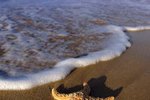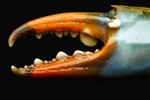
The most famous type of annelid is the beloved earthworm, although several other types -- including worms closely related to the earthworm, as well as leeches -- can be found. Marine worms, mostly known as polychaetes, are also closely related, encompassing such animals as lugworms, clam worms, bristleworms, fire worms and sea mice. To our knowledge today, roughly 9,000 species of annelid exist, all following the same basic body plan.
Long Body
As demonstrated by the earthworm body plan, annelids are long and lacking leg structures. While polychaetes have large collections of bristles extending outward from their body -- explaining the name, which means “many bristles” -- earthworms have far fewer and leeches have none. These bristles, also called setae, project through the wall of the cuticle, or outer covering, A few marine worms, notably the calcerous tubeworm (Serpula vermicularis) also have feather-like radial appendages extending from the fronts of their bodies.
Segmented Structures
Annelids are characterized by segments, which you can again see if you look at an earthworm. The ridges running along the body mark where the inner cavity is segmented inside, forming individual sections of the circulatory, nervous and digestive systems. Each of these segments is called a somite, and by using muscles located in that specific area, can move independent of the other segments. Muscles run both the length of the body, and circularly around the circumference of the body.
Hydrostatic Skeleton
The hydrostatic skeleton is composed of fluid-filled cavities called coelom, which exist in each somite. These cavities are divided by wall-like structures called septa, which help to contain the fluid in separate cavities and maintain the high pressure level. Because of this, the cavities act like a kind of skeleton, against which muscles can brace to move the annelid’s body forward. By squeezing on an individual cavity, muscles lengthen it and induce propulsion.
Body Systems
Annelids possess a digestive tract much like ours. Each has a mouth and an anus, and a variety of organs, including an intestine, between the two. They also have a closed circulatory system, meaning their bodies recycle blood, and five hearts to help move it along. Annelids have no respiratory system, breathing through their skin, and a simple nervous system composed of a brain and nerve cord. They are hermaphroditic, meaning they possess both male and female sex organs.
References
- University of California Berkeley: Introduction to the Annelida
- Animal Diversity Web: Annelida
- University of Walla Walla: Serpula Vermucularis
- BioKids: Segmented Worms
- Dyersberg State Community College: Annelida
- North Carolina State University: Introduction to the Hydrostatic Skeleton
- Boundless: Hydrostatic Skeleton
Photo Credits
-
Ryan McVay/Photodisc/Getty Images
Writer Bio
Sarah Moore has been a writer, editor and blogger since 2006. She holds a master's degree in journalism.




